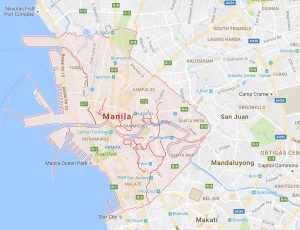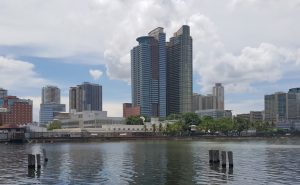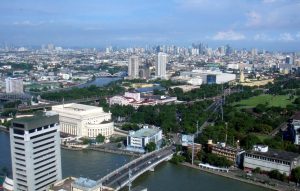Manila City serves as the capital city of the Philippines and was nicknamed as “Pearl of the Orient”.
History
Manila was known before as “Ginto” (gold) or “Suvarnadvipa” by neighboring settlements and was officially named as the Kingdom of Maynila or the “Kota Seludong”, one of the three major city-states that dominated the area by the lower reaches and mouth of the Pasig River before the arrival of the Spaniards.During the latter half of the Ming Dynasty, the kingdom flourished as a result of direct trade relations with China. Its rulers, who lived in the Ancient Tondo which was considered as their traditional capital of the empire, were sovereign kings and were addressed as “panginoon” (lords); “anak banwa” (son of heaven); or “lakandula” (lord of the palace).
Before 15th century, the city was invaded by Sultan Bolkiah of Brunei and was made an Islam community. Some areas with alliance to China were attacked thus making it as Bruneian satellite state. Because of these and with the arrival of traders and proselytes from Malaysia and Indonesia, the city became an Islam community.
Year 1571, Spanish conquistador Miguel Lopez de Legazpi founded the Manila and was made as the capital of the Philippine islands which Spain would control for the next three centuries, from 1565 to 1898.
Population/ Language/ Area
 The total population of the city as of 2010 was 1,652,171. This total population lives in the total land area of 38.55 km², making the Manila city as the most densely populated city in the world.
The total population of the city as of 2010 was 1,652,171. This total population lives in the total land area of 38.55 km², making the Manila city as the most densely populated city in the world.
The vernacular language is Filipino, based mostly on the Tagalog of surrounding areas. This Manila form of speaking Tagalog has essentially become the “lingua franca” or the language systematically used as way of communication in the Philippines. It spread throughout the archipelago through mass media and entertainment. Meanwhile, English is the language most widely used in education, business, and heavily in everyday usage throughout the Metro Manila region and the Philippines itself. A number of older residents can still speak basic Spanish, which was a mandatory subject in the curriculum of Philippine universities and colleges, and many children of Japanese, Indian, Arab or other migrants or expatriates also speak their parents’ languages at home, aside from English and/or Filipino for everyday use. Minnan Chinese (known as Lannang-oe) is spoken by the city’s Chinese-Filipino community.
Products and Services
Manila’s economy is diverse and multifaceted. With its excellent protected harbor, Manila serves as the Chief Seaport of the Country. Diverse manufacturers produce industrial-related products such as chemicals, textiles, clothing, and electronic goods. Food and beverages and tobacco products also are produced. There are also local entrepreneurs who continue to process primary commodities for export including rope, plywood, refined sugar, copra, and coconut oil. The food-processing industry is one of the most stable major manufacturing sector in the city. Manila is also a major publishing center in the Philippines.
Business Opportunity
 One of the largest projects within the city is the ₱5 billion development by Ayala Land Inc., the Celadon Residences. Binondo has begun to be revitalized along with Divisoria, and several high-rise condominiums and offices are rising. Recently, a 20-hectare development was planned by the city government within the Port Area. A blueprint was created for the development of the area while the city government waits for President Aquino to authorize the use of the idle land. An area within the North Harbor was invested in by the San Miguel Corporation, which plan to build a ₱20 billion development known as San Miguel City. This would be a new business area located within the Metropolis which then serve the shipping requirements of the different divisions of the San Miguel Corporation. Anchor Land Holdings, a real estate developer, is spearheading the construction of condominiums and commercial spaces in Manila with most of their projects located within the city.
One of the largest projects within the city is the ₱5 billion development by Ayala Land Inc., the Celadon Residences. Binondo has begun to be revitalized along with Divisoria, and several high-rise condominiums and offices are rising. Recently, a 20-hectare development was planned by the city government within the Port Area. A blueprint was created for the development of the area while the city government waits for President Aquino to authorize the use of the idle land. An area within the North Harbor was invested in by the San Miguel Corporation, which plan to build a ₱20 billion development known as San Miguel City. This would be a new business area located within the Metropolis which then serve the shipping requirements of the different divisions of the San Miguel Corporation. Anchor Land Holdings, a real estate developer, is spearheading the construction of condominiums and commercial spaces in Manila with most of their projects located within the city.
Tourist Spots
Tourism in Manila attracts over 1 million tourists each year. Some of the always visited destinations are the walled city of Intramuros, Manila Zoo, the City Chinatown and the most recognizable icon in the Philippines, the Rizal Park. The city is also famous for its events such as the feast of Black Nazarene, free performances of the celebrities in Rizal Park and other events in the Cultural Center of the Philippines.
Other notable museums in the city are:
- Bahay Tsinoy – one of Manila’s most prominent museums documenting the Chinese lives and contributions in the Philippine history.
- Intramuros Light and Sound Museum – chronicles the Filipinos desire for freedom during the revolution under Rizal’s leadership and other revolutionary leaders.
- Metropolitan Museum of Manila – exhibits the Filipino arts and culture.
- Museum of Manila – exhibits the city’s culture and history.
- Museo Pambata – children’s museum
- Museum of Philippine Political History – shows the notable political events in the country
- National Museum of the Philippines (includes the Museum of the Filipino People) – exhibits life, culture and history of the country
- Parish of the Our Lady of the Abandoned and the San Agustin Church Museum – houses religious artifacts
- UST Museum of Arts and Sciences – a university museum dedicated to contemporary arts and science and technology.
